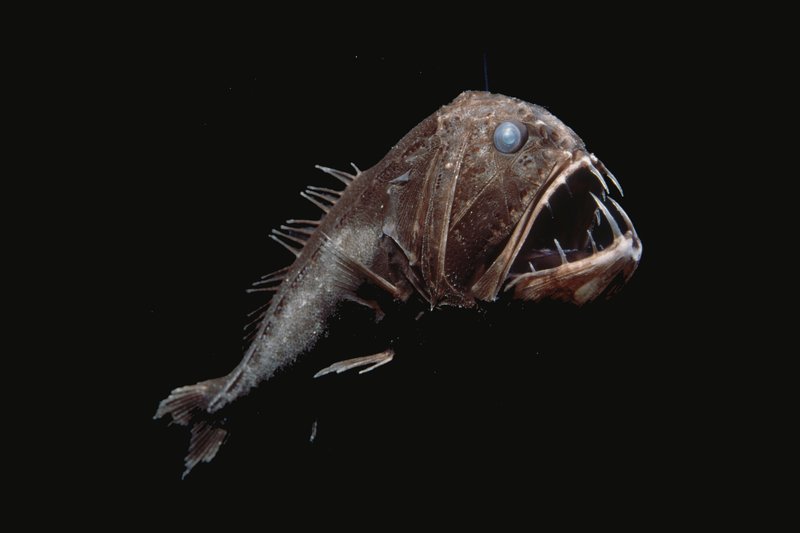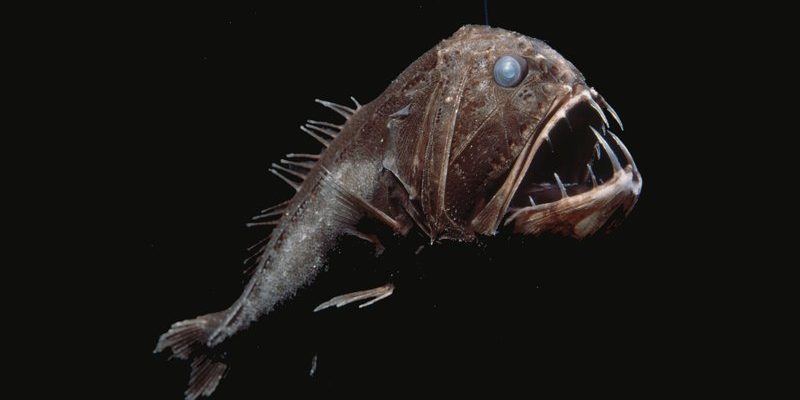
The Fangtooth Fish is one of the ocean’s more bizarre residents, sporting a look that could easily win a “creepiest fish” contest. With its large mouth and jagged teeth, it may not win any beauty awards, but what it lacks in looks, it makes up for in fascinating adaptations. If you’ve ever seen a creature that seems straight out of a science fiction movie, this fish is it.
Living in the darkest depths of the ocean, around 5,000 to 11,000 feet below the surface, the Fangtooth Fish has adapted to survive in an environment that is high-pressure, cold, and nearly devoid of light. Their unique features help them thrive despite the harsh conditions of their deep-sea habitat. Let’s dive deeper into the world of this extraordinary fish!
Physical Characteristics
The Fangtooth Fish has a striking appearance that sets it apart from many other marine species. Adult Fangtooths reach lengths of about 6 to 12 inches, but their most distinctive feature is undoubtedly their oversized teeth. The teeth are so large that they can’t fit into their mouths, which gives them an almost cartoonish, yet menacing look. When their mouths are closed, the tips of the teeth can be visibly seen protruding, reminiscent of a character from a monster movie.
These fish have a dark, almost black coloration, which allows them to blend into the abyssal surroundings. Their bodies are streamlined, aiding in maneuverability through the cold waters where they reside. One fascinating adaptation is their large eyes, which help them detect even the faintest light or movement, crucial for spotting prey in almost complete darkness.
Another interesting fact is their unusual swim bladder. Unlike many fish that use this organ for buoyancy, Fangtooth Fish have a modified swim bladder that allows them to adjust pressure. This is vital for survival when they are swimming between different depths in the ocean, where pressure changes can be extreme.
Habitat and Distribution
The Fangtooth Fish calls the deep sea home, specifically in the bathypelagic zone, which ranges from about 3,300 to 13,100 feet deep. This part of the ocean is a world of extremes, filled with crushing pressure and frigid temperatures. Their habitat spreads across the globe, found in both the Atlantic and Pacific Oceans. You might picture the depths as a barren wasteland, but they’re teeming with life, particularly during the twilight hours when bioluminescent creatures rise from the depths to feed.
Fangtooths typically dwell in deep, dark waters but can sometimes be found near the surface. They often move between different depths to hunt for food, utilizing their keen eyesight to locate prey. The unique pressure balance they have allows them to thrive across such varying depths, making them adaptable in their eerie environment.
Moreover, these fish often face a multitude of challenges in their ecosystem. While they are top predators of their habitat, they also need to navigate complex food webs that include other deep-sea creatures. Their ability to camouflage and hide from larger predators allows them to survive in this competitive landscape.
Diet and Feeding Habits
The Fangtooth Fish is a carnivore, primarily feeding on smaller fish, shrimp, and other small crustaceans that inhabit the deep sea. Their large mouths and sharp teeth enable them to capture and devour prey such as lanternfish and other bioluminescent organisms. They use their exceptional sense of sight to spot bioluminescent creatures, which often serve as a dinner bell in the dark abyss.
Interestingly, Fangtooth Fish are also known to exhibit ambush tactics. They often remain still, camouflaged against the dark backdrop of their environment, waiting for unsuspecting prey to swim by. When the moment is right, they strike quickly—sharp teeth ensuring a successful catch. This method is particularly effective in their habitat, where food is sparse and energy conservation is vital.
Because food is not always abundant in the depths of the ocean, the Fangtooth Fish has developed the ability to eat and store whatever they can. This means they can consume prey that might seem disproportionately large relative to their body size. Their voracious appetite is crucial for survival, given the unpredictable nature of their food supply.
Reproduction and Life Cycle
The reproductive habits of Fangtooth Fish remain somewhat mysterious, primarily because of their deep-sea habitat. Like many creatures of the deep, they likely have unique breeding strategies to enhance their chances of survival. It’s believed that they spawn during certain times of the year when environmental conditions are favorable, but specific details about their mating rituals and egg-laying habits are not well-documented.
When Fangtooth Fish do spawn, they probably release eggs into the water column, which are then fertilized externally. The eggs are likely handled in a way that increases their chances of survival against the harsh conditions in their environment. The larvae that hatch are thought to be planktonic, drifting in the ocean currents until they grow and descend into deeper waters.
Over time, these young fish will undergo changes, developing the characteristic traits of adult Fangtooth Fish as they grow. The lifespan of these fascinating creatures is still not definitively known, but they are believed to live for several years, with growth rates dependent on factors like food availability and environmental conditions.
Conservation Status
Despite their eerie appearance, Fangtooth Fish aren’t currently considered endangered; however, like many deep-sea species, they face potential threats from human activities. Deep-sea fishing, pollution, and climate change all pose challenges to their populations. As explorers venture into these depths, they sometimes unintentionally disrupt delicate ecosystems, which can have cascading effects on all species, including the Fangtooth Fish.
Increased carbon levels and temperature changes in the ocean can also impact their habitats, altering the availability of food sources. Because these fish are part of a larger ecosystem, any changes can affect their survival. Preservation of deep-sea habitats is crucial for maintaining the balance of the marine environment.
Effective conservation efforts are essential for protecting Fangtooth Fish and their habitats. This might include implementing regulations on deep-sea fishing practices, minimizing pollution, and conducting further research to understand their role in the ecosystem. By raising awareness and advocating for sustainable practices, we can help ensure these extraordinary fish continue to thrive in the ocean’s depths.
Interesting Facts About Fangtooth Fish
| Scientific Name: | Anoplogaster cornuta |
| Average Size: | 6 to 12 inches |
| Habitat: | 5,000 to 11,000 feet deep |
| Diet: | Smaller fish, shrimp, and crustaceans |
| Eyes: | Large, adapted for low light |
| Teeth: | Oversized for capturing prey |
| Lifespan: | Several years (exact details unknown) |
FAQ
Where do Fangtooth Fish live?
Fangtooth Fish are primarily found in the deep ocean, particularly in the bathypelagic zone, where they can thrive in complete darkness at depths of 5,000 to 11,000 feet. Their habitat spans across both the Atlantic and Pacific Oceans, showing just how adaptable they are to different environments within the deep sea.
What do Fangtooth Fish eat?
These fish are carnivorous and feast on smaller fish, crustaceans, and various other creatures that inhabit their dark waters. Their keen eyesight and ambush tactics make them effective hunters despite the limited food supply found in their environment.
How do Fangtooth Fish reproduce?
While not much is known about their reproductive habits, it’s believed that Fangtooth Fish spawn by releasing eggs into the water column for external fertilization. The larvae likely drift in the ocean currents until they reach maturity and descend into deeper waters.
Are Fangtooth Fish dangerous to humans?
No, Fangtooth Fish are not dangerous to humans. They reside in extremely deep waters, far away from human contact. Their menacing appearance is more a product of their adaptations to their exclusive habitat than any threat they pose to us.
What adaptations help Fangtooth Fish survive in deep water?
Fangtooth Fish have several fascinating adaptations, such as large eyes for detecting faint light, oversized teeth for catching prey, and a specialized swim bladder that helps them cope with varying water pressure. These features are essential for thriving in their extreme habitat.
Can Fangtooth Fish be kept in aquariums?
While Fangtooth Fish are visually intriguing, they are not suitable for home aquariums. Their deep-sea nature and specific habitat requirements make it nearly impossible to replicate their environment adequately, resulting in high stress and poor health.
What threats do Fangtooth Fish face?
The Fangtooth Fish faces threats mainly from human activities such as deep-sea fishing and pollution. Climate change also poses risks by altering their habitats and food availability, stressing the need for conservation efforts in deep-sea ecosystems.
How long do Fangtooth Fish live?
The exact lifespan of Fangtooth Fish is not thoroughly documented, but they are believed to live for several years depending on various factors, including their environment and food supply. Further research is necessary to understand their longevity.
Why do Fangtooth Fish have such large teeth?
Their large teeth are a result of evolutionary adaptations for hunting in their deep-sea habitats. These oversized adaptations allow them to seize and hold onto slippery prey, aiding in their survival in the sparse oceanic environment.
What role do Fangtooth Fish play in their ecosystem?
Fangtooth Fish are important predators in their deep-sea environments, helping maintain the balance of the marine food web. By controlling populations of smaller fish and crustaceans, they play a crucial role in their ecosystem, contributing to the overall health of the ocean.

